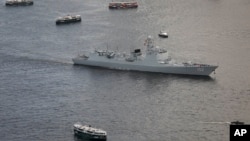The Cambodian navy last week hosted a lavish reception for three Chinese warships that docked in the southern port of Sihanoukville.
The visit follows denials by the Cambodian government over claims that China was seeking to create a de facto military base off Cambodia’s southern coast.
Observers said the visit was part of China’s expansion of its maritime military might in the Southeast Asian region, where Beijing is in dispute with at least four claimant states over territorial claims in the South China Sea.
The warships were led by Vice Admiral Xu Haihua, deputy chief of the Chinese Naval Staff. He was welcomed by Defense Minister Tea Banh and senior navy officials at the Ream Naval Base.
The three warships -- the Wuhu, Handan and Dongping Lake -- are under the command of China’s Northern Theatre Command and conduct regular assignments in the Yellow Sea near the Korean Peninsula.
The Cambodian navy said the visit was intended to “enhance solidarity ties, friendship, and cooperation between both militaries of Cambodia and China.”
Cambodia has welcomed Chinese economic and military aid with open arms. In a visit in June last year, Chinese Defense Minister Wei Fenghe pledged some $100 million in aid to the Royal Cambodian Armed Forces. Both militaries are planning to hold a third joint army exercise in March.
Collin Koh, a naval security expert with the Nanyang Technological University in Singapore, said the visit would embolden Cambodia – not just economically but also militarily -- amid growing geopolitical rivalries in the Indo-Pacific region.
“Beyond the building of a modest level of interoperability, more because of the level of sophistication of the Royal Cambodian Navy relative to the PLA Navy, such port calls are designed more as a politically symbolic act,” Koh told VOA Khmer in an email.
The U.S., however, may seek to “compensate for its loss of influence” in mainland Southeast Asia through further enhancement of its engagement with Vietnam, he added.







